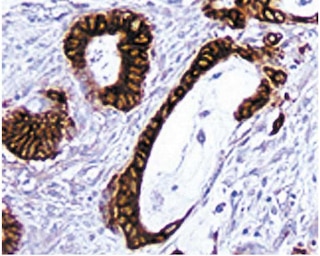Old Browser
This page has been recently translated and is available in French now.
Looks like you're visiting us from {countryName}.
Would you like to stay on the current country site or be switched to your country?




Immunohistochemical staining of lymphocytes and endothelial cells. The frozen section of normal mouse small intestine was reacted with 3E2 mAb. The positive staining can be identified by the intense brown labeling of endothelium, lymphocytes, and stroma of the lamina propria.


BD Pharmingen™ Purified Hamster Anti-Mouse CD54

Regulatory Status Legend
Any use of products other than the permitted use without the express written authorization of Becton, Dickinson and Company is strictly prohibited.
Preparation And Storage
Recommended Assay Procedures
Immunohistochemistry: The 3E2 antibody is recommended to test for immunohistochemical staining of acetone-fixed frozen sections and zinc-fixed paraffin sections. Tissues tested were mouse spleen and thymus. The clone 3E2 is not recommended for formalin-fixed paraffin embedded sections. The antibody stains lymphocytes, dendritic cells, and macrophages. The isotype control recommended for use with this antibody is purified hamster IgG (Cat. No. 550344). For optimal indirect immunohistochemical staining, the 3E2 antibody should be titrated (1:10 to 1:50 dilution) and visualized via a three-step staining procedure in combination with biotinylated anti-hamster cocktail (Cat. No. 550335) as the secondary antibody and Streptravidin-HRP (Cat. No. 550946) together with the DAB detection system (Cat. No. 550880). More conveniently, the Anti-Hamster Ig HRP detection kit (Cat. No. 551012) that contains the biotinylated secondary antibody, antibody diluent, streptavidin-HRP and DAB substrate can be used for staining.
A detailed protocol of the immunohistochemical procedure can be found on our website at http://www.bdbiosciences.com/support/resources
Product Notices
- Since applications vary, each investigator should titrate the reagent to obtain optimal results.
- Although hamster immunoglobulin isotypes have not been well defined, BD Biosciences Pharmingen has grouped Armenian and Syrian hamster IgG monoclonal antibodies according to their reactivity with a panel of mouse anti-hamster IgG mAbs. A table of the hamster IgG groups, Reactivity of Mouse Anti-Hamster Ig mAbs, may be viewed at http://www.bdbiosciences.com/documents/hamster_chart_11x17.pdf.
- Caution: Sodium azide yields highly toxic hydrazoic acid under acidic conditions. Dilute azide compounds in running water before discarding to avoid accumulation of potentially explosive deposits in plumbing.
- Source of all serum proteins is from USDA inspected abattoirs located in the United States.
- This antibody has been developed for the immunohistochemistry application. However, a routine immunohistochemistry test is not performed on every lot. Researchers are encouraged to titrate the reagent for optimal performance.
- An isotype control should be used at the same concentration as the antibody of interest.
- Please refer to www.bdbiosciences.com/us/s/resources for technical protocols.
Companion Products




The 3E2 monoclonal antibody specifically binds to CD54 (ICAM-1), a 95-kDa member of the Ig superfamily found on lymphocytes, vascular endothelium, high endothelial venules, epithelial cells, macrophages, and dendritic cells. ICAM-1 is a ligand for LFA1 (CD11a/CD18) and Mac-1 (CD11b/CD18). Its expression is upregulated upon stimulation by inflammatory mediators such as cytokines and LPS. Studies with mouse Icam1-transfected antigen-presenting cells, with CD54-blocking antibodies, and in CD54-deficient mice indicate that CD54 participates in inflammatory reactions and antigen-specific immune responses. In addition, there is evidence that CD54 is a receptor involved in MHC-non-restricted responses to weakly immunogenic tumor cells. The 3E2 antibody has been reported to block in vitro and in vivo intracellular adhesion events involved in immune responses.
Development References (5)
-
Isobe M, Yagita H, Okumura K, Ihara A. Specific acceptance of cardiac allograft after treatment with antibodies to ICAM-1 and LFA-1. Science. 1992; 255(5048):1125-1127. (Biology). View Reference
-
Scheynius A, Camp RL, Pure E. Reduced contact sensitivity reactions in mice treated with monoclonal antibodies to leukocyte function-associated molecule-1 and intercellular adhesion molecule-1. J Immunol. 1993; 150(2):655-663. (Clone-specific). View Reference
-
Springer TA. Adhesion receptors of the immune system. Nature. 1990; 346(6283):425-434. (Clone-specific). View Reference
-
Springer TA. Traffic signals for lymphocyte recirculation and leukocyte emigration: the multistep paradigm. Cell. 1994; 76(2):301-314. (Biology). View Reference
-
Xu H, Gonzalo JA, St Pierre Y, et al. Leukocytosis and resistance to septic shock in intercellular adhesion molecule 1-deficient mice. J Exp Med. 1994; 180(1):95-109. (Biology). View Reference
Please refer to Support Documents for Quality Certificates
Global - Refer to manufacturer's instructions for use and related User Manuals and Technical data sheets before using this products as described
Comparisons, where applicable, are made against older BD Technology, manual methods or are general performance claims. Comparisons are not made against non-BD technologies, unless otherwise noted.
For Research Use Only. Not for use in diagnostic or therapeutic procedures.
Report a Site Issue
This form is intended to help us improve our website experience. For other support, please visit our Contact Us page.